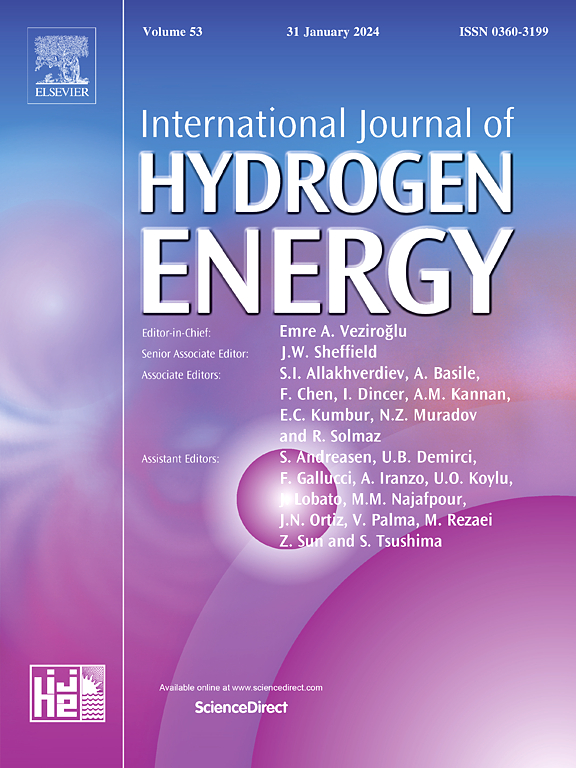Study on the catalytic mechanism of core-shell structure CoCu@BN promoting the hydrolytic dehydrogenation of ammonia borane
IF 8.3
2区 工程技术
Q1 CHEMISTRY, PHYSICAL
引用次数: 0
Abstract
Ammonia borane (NH3BH3, AB) as one of the complex hydrides shows great potential for hydrogen storage. Nevertheless, the lack of efficient catalysts limits the hydrogen release rate. Herein, we reported a heterostructure catalyst consisting of Co and Cu nanoparticles with a boron nitride cladding (defined as CoCu@BN). Remarkably, on the basis of BN shell formation, CoCu particles are confined with a stable nanoscale of around 10 nm. As a result, the optimal Co08Cu0.2@BN catalyst demonstrates excellent catalytic performance, achieving a high TOF of 28.8 molH2 molmetal−1 min−1, which is far superior to the Co@BN and Cu@BN. The catalytic mechanism has been verified, demonstrating that the combined compositional and structural characteristics of Co0·8Cu0.2@BN synergistically induce robust electron transfer. This phenomenon accelerates the cleavage of H2O molecules (the rate-determining step), thereby enhancing the catalytic hydrolysis of AB. The findings presented in this study offer a precise and controllable strategy for designing non-noble metal catalysts aimed at hydrogen production.

核壳结构催化机理研究CoCu@BN促进氨硼烷水解脱氢
氨硼烷(NH3BH3, AB)是一种具有巨大储氢潜力的络合氢化物。然而,缺乏有效的催化剂限制了氢的释放速度。在此,我们报道了一种异质结构催化剂,由Co和Cu纳米颗粒组成,并带有氮化硼包层(定义为CoCu@BN)。值得注意的是,在BN壳形成的基础上,CoCu颗粒被限制在10 nm左右的稳定纳米尺度上。结果表明,Co08Cu0.2@BN催化剂表现出优异的催化性能,TOF达到28.8 molH2 molmetal−1 min−1,远远优于Co@BN和Cu@BN催化剂。验证了催化机理,表明Co0·8Cu0.2@BN的组合组成和结构特征协同诱导了稳健的电子转移。这种现象加速了H2O分子的裂解(速率决定步骤),从而增强了AB的催化水解。本研究的发现为设计以制氢为目标的非贵金属催化剂提供了一种精确和可控的策略。
本文章由计算机程序翻译,如有差异,请以英文原文为准。
求助全文
约1分钟内获得全文
求助全文
来源期刊

International Journal of Hydrogen Energy
工程技术-环境科学
CiteScore
13.50
自引率
25.00%
发文量
3502
审稿时长
60 days
期刊介绍:
The objective of the International Journal of Hydrogen Energy is to facilitate the exchange of new ideas, technological advancements, and research findings in the field of Hydrogen Energy among scientists and engineers worldwide. This journal showcases original research, both analytical and experimental, covering various aspects of Hydrogen Energy. These include production, storage, transmission, utilization, enabling technologies, environmental impact, economic considerations, and global perspectives on hydrogen and its carriers such as NH3, CH4, alcohols, etc.
The utilization aspect encompasses various methods such as thermochemical (combustion), photochemical, electrochemical (fuel cells), and nuclear conversion of hydrogen, hydrogen isotopes, and hydrogen carriers into thermal, mechanical, and electrical energies. The applications of these energies can be found in transportation (including aerospace), industrial, commercial, and residential sectors.
 求助内容:
求助内容: 应助结果提醒方式:
应助结果提醒方式:


